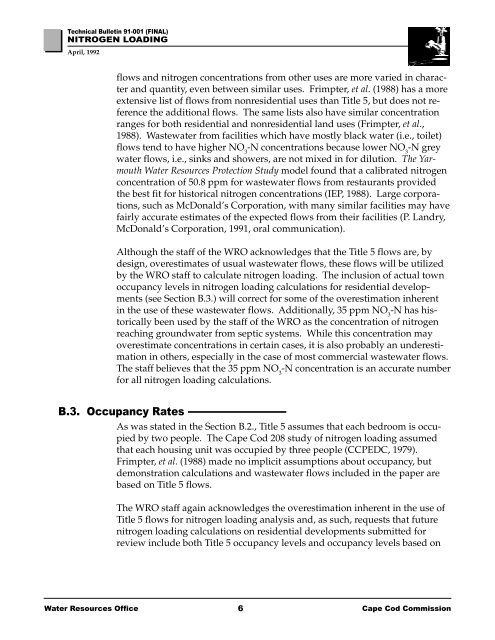Technical Bulletin 91-001 Nitrogen Loading - Cape Cod Commission
Technical Bulletin 91-001 Nitrogen Loading - Cape Cod Commission
Technical Bulletin 91-001 Nitrogen Loading - Cape Cod Commission
You also want an ePaper? Increase the reach of your titles
YUMPU automatically turns print PDFs into web optimized ePapers that Google loves.
<strong>Technical</strong> <strong>Bulletin</strong> <strong>91</strong>-<strong>001</strong> (FINAL)<br />
NITROGEN LOADING<br />
April, 1992<br />
flows and nitrogen concentrations from other uses are more varied in character<br />
and quantity, even between similar uses. Frimpter, et al. (1988) has a more<br />
extensive list of flows from nonresidential uses than Title 5, but does not reference<br />
the additional flows. The same lists also have similar concentration<br />
ranges for both residential and nonresidential land uses (Frimpter, et al.,<br />
1988). Wastewater from facilities which have mostly black water (i.e., toilet)<br />
flows tend to have higher NO 3<br />
-N concentrations because lower NO 3<br />
-N grey<br />
water flows, i.e., sinks and showers, are not mixed in for dilution. The Yarmouth<br />
Water Resources Protection Study model found that a calibrated nitrogen<br />
concentration of 50.8 ppm for wastewater flows from restaurants provided<br />
the best fit for historical nitrogen concentrations (IEP, 1988). Large corporations,<br />
such as McDonald’s Corporation, with many similar facilities may have<br />
fairly accurate estimates of the expected flows from their facilities (P. Landry,<br />
McDonald’s Corporation, 19<strong>91</strong>, oral communication).<br />
Although the staff of the WRO acknowledges that the Title 5 flows are, by<br />
design, overestimates of usual wastewater flows, these flows will be utilized<br />
by the WRO staff to calculate nitrogen loading. The inclusion of actual town<br />
occupancy levels in nitrogen loading calculations for residential developments<br />
(see Section B.3.) will correct for some of the overestimation inherent<br />
in the use of these wastewater flows. Additionally, 35 ppm NO 3<br />
-N has historically<br />
been used by the staff of the WRO as the concentration of nitrogen<br />
reaching groundwater from septic systems. While this concentration may<br />
overestimate concentrations in certain cases, it is also probably an underestimation<br />
in others, especially in the case of most commercial wastewater flows.<br />
The staff believes that the 35 ppm NO 3<br />
-N concentration is an accurate number<br />
for all nitrogen loading calculations.<br />
B.3. Occupancy Rates<br />
As was stated in the Section B.2., Title 5 assumes that each bedroom is occupied<br />
by two people. The <strong>Cape</strong> <strong>Cod</strong> 208 study of nitrogen loading assumed<br />
that each housing unit was occupied by three people (CCPEDC, 1979).<br />
Frimpter, et al. (1988) made no implicit assumptions about occupancy, but<br />
demonstration calculations and wastewater flows included in the paper are<br />
based on Title 5 flows.<br />
The WRO staff again acknowledges the overestimation inherent in the use of<br />
Title 5 flows for nitrogen loading analysis and, as such, requests that future<br />
nitrogen loading calculations on residential developments submitted for<br />
review include both Title 5 occupancy levels and occupancy levels based on<br />
Water Resources Office 6<br />
<strong>Cape</strong> <strong>Cod</strong> <strong>Commission</strong>
















